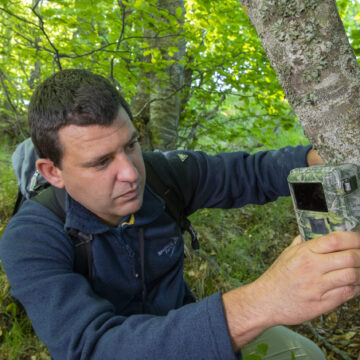 Mario Cipollone
Mario Cipollone
Team leader of Central Apennines
How would you characterise your rewilding area?
Historic villages and dramatic landscapes with outstanding opportunities to experience majestic wildlife and wilderness experiences a short drive from Rome. Brown bears, wolves, large ungulates and large birds of prey are the main attractions, complemented by excellent Italian food, wine and hospitality and the opportunity to meet livestock owners and mountain people and sample their unique culture. I invite every nature lover to come here and enjoy what our surprising nature can offer in the most respectful way. This truly is the wild heart of Italy!
What have the major achievements been in your rewilding area to date?
As a project manager for the Salviamo l’Orso team I was involved in a number of major achievements:
- Establishing the first “bear smart community” through the provision of electric fences and bearproof waste bins, and the raising of awareness to prevent bear-human conflict with a dramatic reduction of bear-related damage. This successful conservation action has been now expanded to different areas across the entire range of the Marsican brown bear.
- The mitigation of bear-related traffic accidents through the installation of reflective studs, road signs and optical systems, and a reduction of the speed limit on Road SR83 to 70 km/h.
- Reduction of bear-beekeeping conflicts by securing several apiaries with electric fences, paying compensation for damage to non-secured properties, and promoting bear smart practices.
- Promotion of bear-friendly products, creating an extra incentive for local entrepreneurs to protect bears.
- Organisation of volunteer programs involving Italian and foreign students in conservation actions, bringing new life and energy to local communities.
All of these actions, while specifically aimed at boosting the local bear population, are also having a wider positive impact on Central Apennine ecosystems.
What would you like to see achieved in your rewilding area in the next five years?
Over the next five years I would like to see significant growth of the Marsican bear population with an extension of its core area, the comeback of scavengers and raptors which inhabited this area before hunting and poisoning took their toll, and the expansion of the European otter in our rivers. I would also like to see an increased environmental awareness amongst our local stakeholders, and the increased adoption of best practices for coexistence with wildlife, which form the basis of our conservation efforts.

